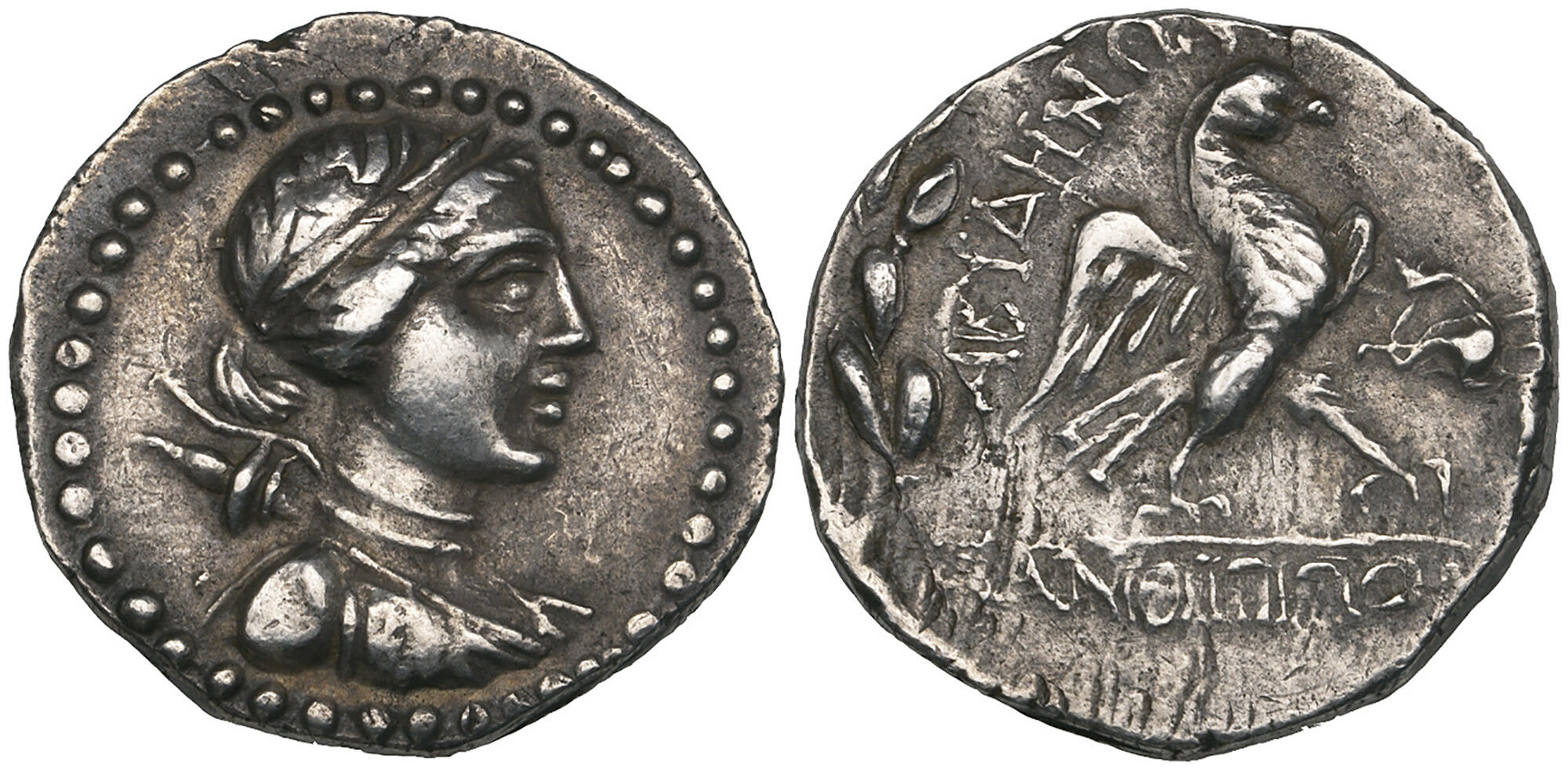Abydus, silver, tetradrachms (110-70 BCE)
From SILVER
110 BCE - 70 BCE Silver 13,951 kg
Description
| ObverseInscription or printing placed on the obverse.: | Bust of Artemis right, bow and quiver at shoulder |
| ReverseInscription or printing placed on the reverse.: | ΑΒΥΔΗΝΩΝ (Greek).Eagle standing right, in field before, dolphin on trident head, in ex., ΞΑΝΘΙΠΠΟΥ |
Mint and issuing power
| MintIdentifies the place of manufacture or issue of a numismatic object.: | Abydus | Ancient regionAncient region.: | Troas | Modern countryModern country: Turkey | AuthorityIdentifies the issuing power. The authority can be "pretended" when the name or the portrait of X is on the coin but he/she was not the issuing power. It can also be "uncertain" when there is no mention of X on the coin but he/she was the issuing power according to the historical sources: |
Chronology
| FromIdentifies the initial date in a range assigned in a numismatic context. | 110 BCE | toIdentifies the final date in a range assigned in a numismatic context.. | 70 BCE | PeriodTime period of the numismatic object.: Hellenistic 323-30 BC |
Physical description
| MetalThe physical material (usually metal) from which an object is made.: | Silver |
Median weightMedian of the weights of numismatic objects (in grams). in grams | 16.60 | DenominationTerm indicating the value of a numismatic object. Examples: tetradrachm, chalkous, denarius.: | tetradrachm |
StandardStandard.: | Attic |
Image

S1652 Abydos tetradrachm.jpg [1]
References
| Die study referencePublication of the study: | Callataÿ 19961Callataÿ 1996 | ||
| Coin series referenceReference to coin series study: | Sear II2Sear II, n° 4013-4014 | ||
Obverse dies distribution
| FrequencyFrequency of specimen in distribution. ᵖ | Number of obversesNumber of obverse dies. ᵖ (o) | % (o) | Number of coinsNumber of coins. (n) | % (n) | Die nameName(s) of the die(s). |
| 1 | 13 | 37.14 | 13 | 10.4 | 2, 3, 4, 5, 6, 7, 8, 9, 22, 23, 25, 33, 35 |
| 2 | 7 | 20 | 14 | 11.2 | 1, 10, 11, 20, 21, 24, 27 |
| 3 | 3 | 8.57 | 9 | 7.2 | 12, 19, 29 |
| 4 | 3 | 8.57 | 12 | 9.6 | 17, 18, 28 |
| 6 | 3 | 8.57 | 18 | 14.4 | 15, 30, 32 |
| 7 | 2 | 5.71 | 14 | 11.2 | 13, 14 |
| 8 | 1 | 2.86 | 8 | 6.4 | 31 |
| 10 | 1 | 2.86 | 10 | 8 | 26 |
| 13 | 1 | 2.86 | 13 | 10.4 | 16 |
| 14 | 1 | 2.86 | 14 | 11.2 | 34 |
| Total | 35 of 35 | 100 | 125 of 125 | 100 |
Reverse dies distribution
no distribution is available
Quantification
| Number of obversesNumber of obverse dies. ᵖ (o) | 35 | Number of singletons (o1)The number of singleton coins. ᵖ | 13 |
| Number of reverse diesNumber of reverse dies. (r) | 95 | Number of coinsNumber of coins. (n) | 125 |
| Coins per obverse dieNumber of coins per obverse die. (n/o) | 3.57 | Coins per reverse dieNumber of coins per reverse die. (n/r) | 1.32 |
| Reverse per obverse ratioRatio of obverse dies divided by reverse dies. (r/o) | 2.71 | Percentage of singletons (o1)number of coins (n) divided by the number of singletons (o1) ᵖ | 37.14 % |
| Original number of dies (O) (Carter 1983 formula)The estimation of the number of coins according to Carter 1983 ᵖ | 42.02 | Coins struck if 20,000 as average productivity per dieCoins made if the average productivity for obverses (according to Carter) is 20,000. ᵖ | 840,400 |
| Original number of dies (O) (Esty 2011 formula)The estimation of the number of coins according to the singleton formula in Esty 2011 ᵖ (O) | 48.61 | Survival rate if 20,000 as average productivity per dieSurvival rate if average productivity is 20,000. ᵖ | 0.00015 |
| Coverage (o = % of O) (Esty 1984 formula)Esty 1984 - coverage (% of O) ᵖ (o = % of O) | 89.6% | Die productivity if survival rate 1/2,000Average productivity if survival rate is 1/2,000. ᵖ | 5,949.55 |
| Weight of silver (in kg) if 20,000 coins per die (O = Carter formula)Carter 1983 * Median weight * 20000 (*10 if gold or electrum) ᵖ | 13,951 kg <br /> 13,951 kg | Die productivity if survival rate 1/5,000Average productivity if survival rate is 1/5,000. ᵖ | 14,873.87 |
Remarks
Most likely one single workstation Likely military